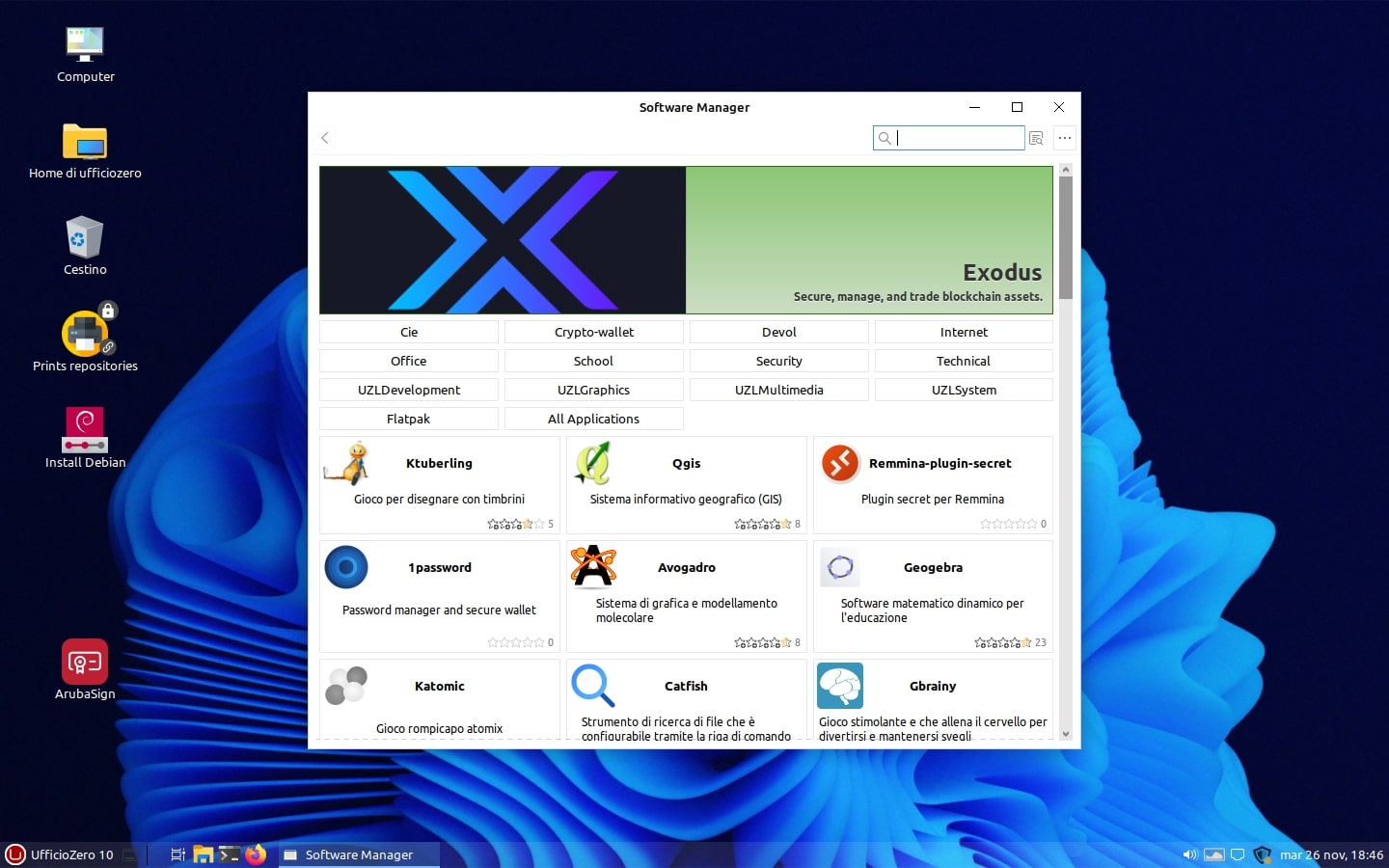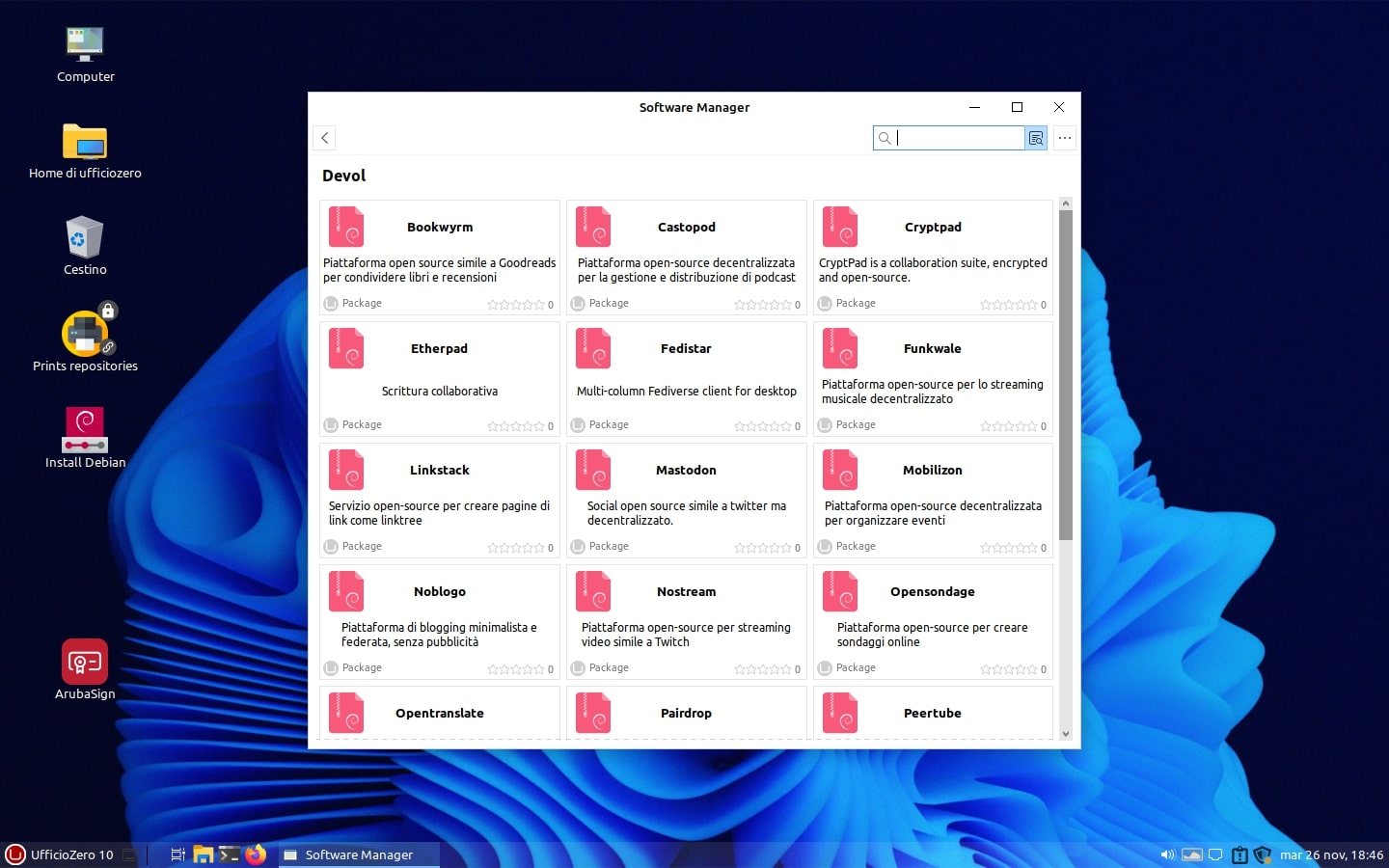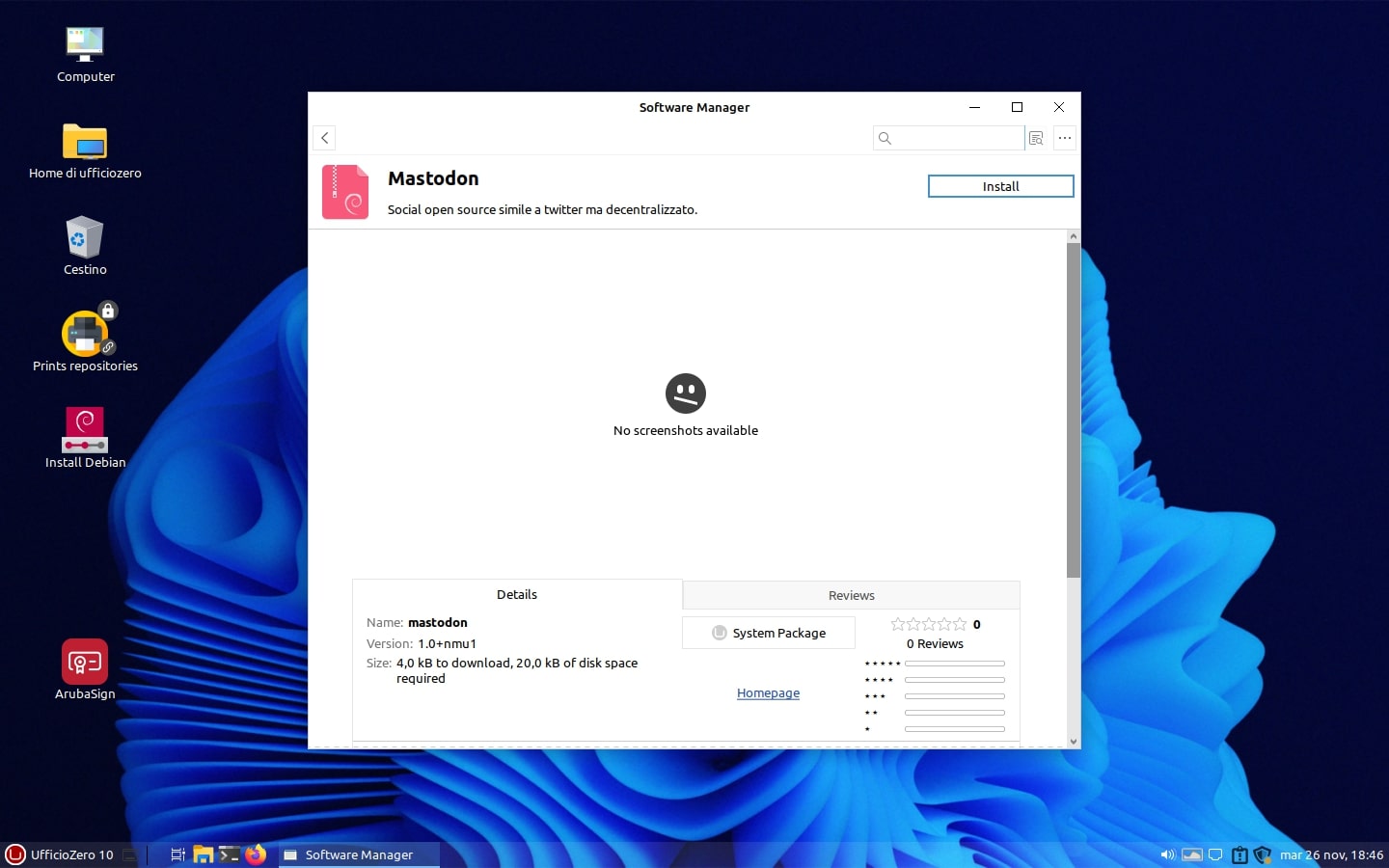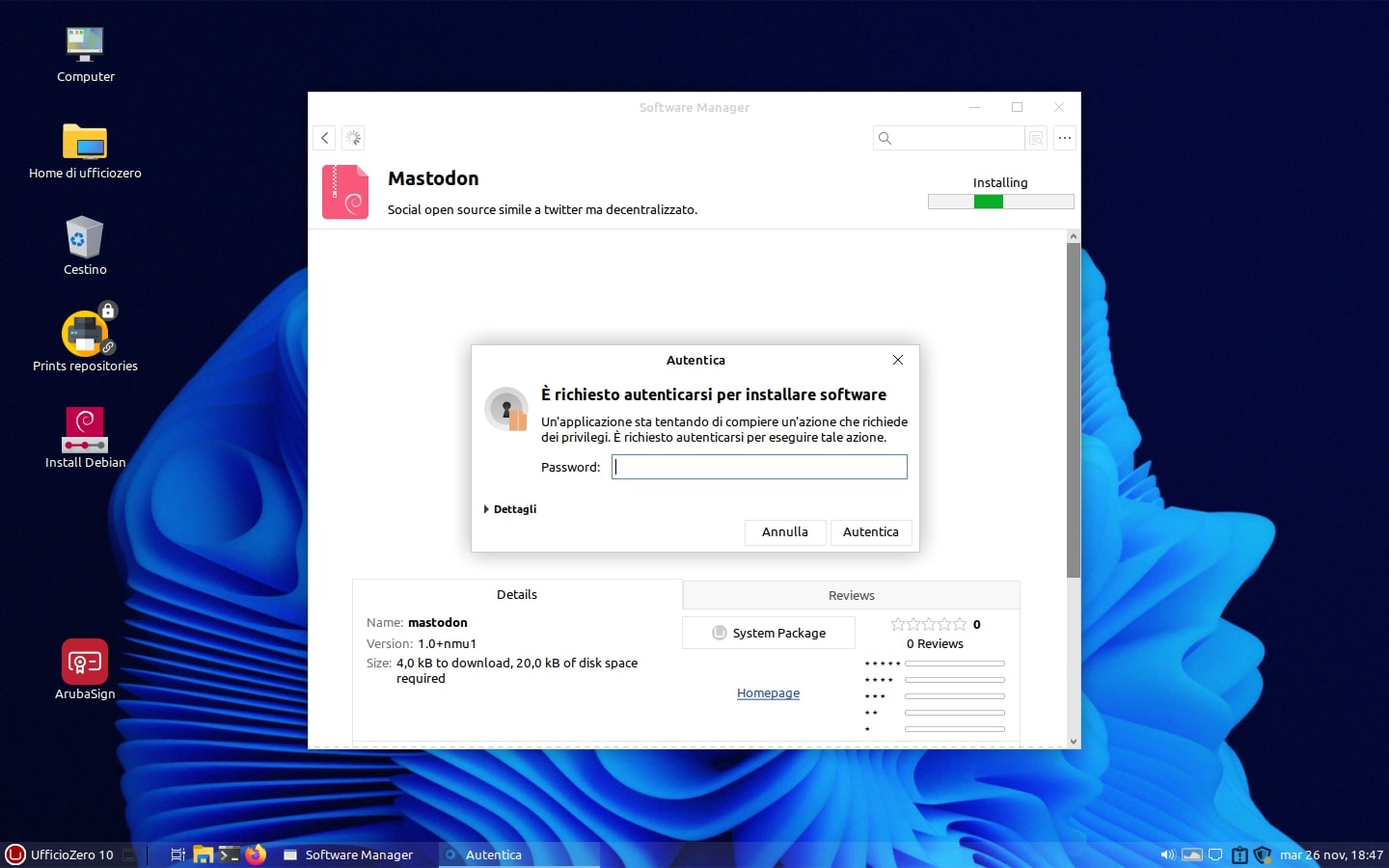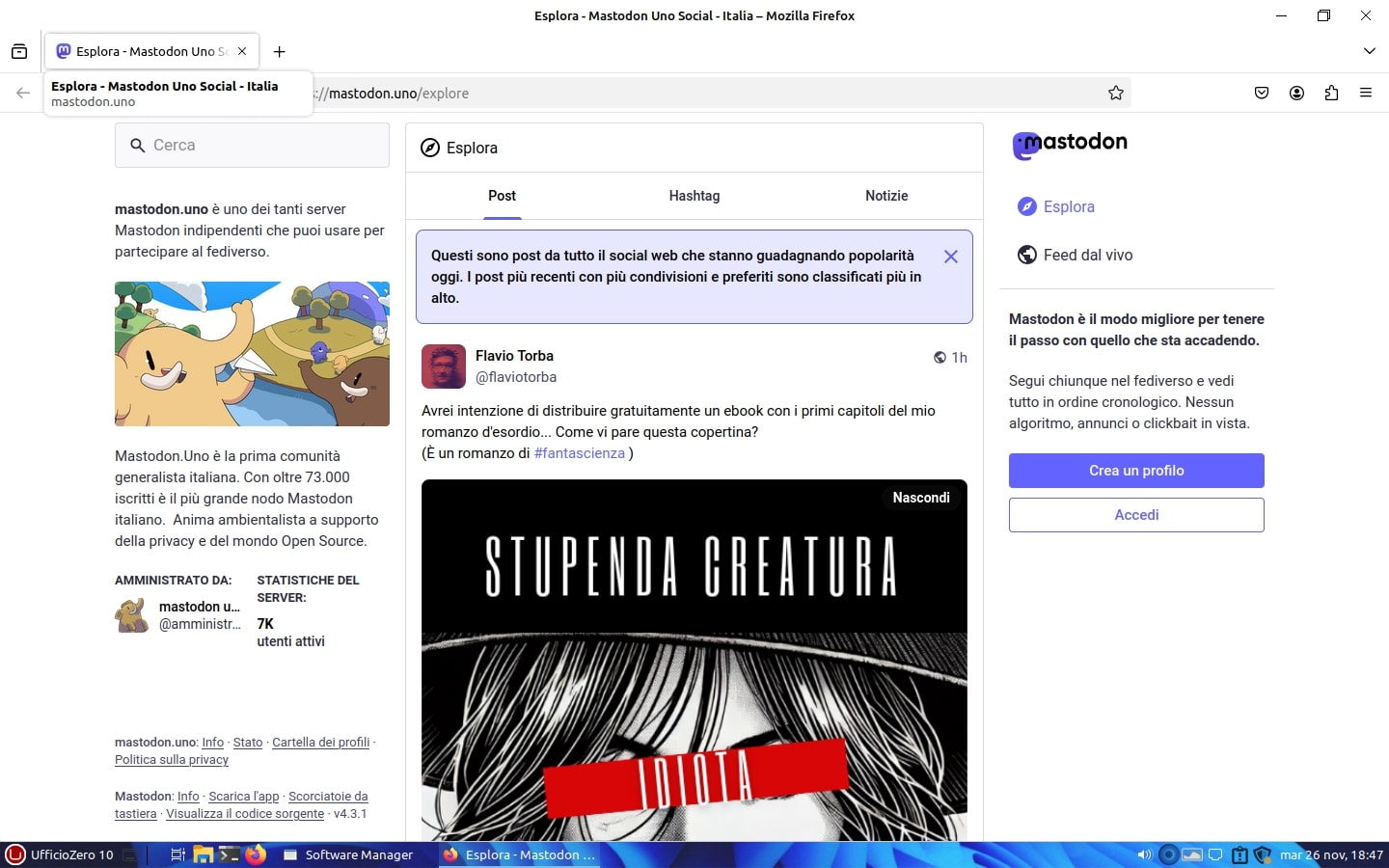Mastodon.Uno è il servizio del Fediverso offerto e gestito da Devol
guida di installazione ed utilizzo sulle release 11 e 10 Plus
Julian Del Vecchio 02/12/2024 0
Vi abbiamo annunciato giorni fa la collaborazione tra Ufficio Zero Linux OS e Devol ma oggi scendiamo nel dettaglio per il social Mastodon.Uno gestito da Devol.
Sulla release 10 Plus è possibile installare il social alternativo a X/Twitter aprendo il Postinstall e cliccando sulla sezione Devol.
Entrati nella schermata con le varie applicazioni offerte dagli attivisti di Devol, si può selezionare ed installare il servizio Mastodon e, ad installazione conclusa, recandovi nel menu principale di Ufficio Zero Linux OS 10 Plus, nella categoria Web troverete il link al servizio mastodon.uno
Potete cliccare ed avviare mastodon su pagina web, creare un vostro account ed infine potete decidere se utilizzare il browser web per i vostri tooth oppure scegliere se installare uno dei client messo a vostra disposizione tra Fedistar o Whalebird, sempre tramite il Postinstall nella categoria Devol.
Di seguito una panoramica dei passaggi di installazione di Mastodon.uno targato Devol!
Il meccanismo di installazione di Mastodon.uno e di altri servizi gestiti da Devol è lo stesso anche sulla release 11.
Anche Ufficio Zero Linux OS è attiva su mastodon.uno a questo link per cui potrete seguirci sul social network decentralizzato!
We announced a few days ago the collaboration between Ufficio Zero Linux OS and Devol but today we go into detail for the Mastodon.Uno social network managed by Devol.
On the 10 Plus release it is possible to install the alternative social network to X/Twitter by opening the Postinstall and clicking on the Devol section.
Once you have entered the screen with the various applications offered by Devol activists, you can select and install the Mastodon service and, once installation is complete, by going to the main menu of Ufficio Zero Linux OS 10 Plus, in the Web category you will find the link to the mastodon.uno service You can click and start mastodon on the web page, create your own account and finally you can decide whether to use the web browser for your teeth or choose whether to install one of the clients made available to you between Fedistar or Whalebird, always via the Postinstall in the Devol category.
Below is an overview of the installation steps for Mastodon.uno branded Devol!
The installation mechanism for Mastodon.uno and other Devol-managed services is the same on release 11.
Ufficio Zero Linux OS is also active on mastodon.uno at this link so you can follow us on the decentralized social network!
Potrebbero interessarti anche...
Julian Del Vecchio 23/09/2024
Lorenzo DM recensisce Ufficio Zero Linux OS release 11.x
Siamo felici di avere sempre più conferme della bontà del nostro progetto e di aver trovato un nuovo amico che ha egregiamente recensito Ufficio Zero Linux OS e la sua release 11.1 a 64bit con DM Cinnamon.
Tali conferme ci spingono ad offrire un prodotto gratuito, sempre migliore, grazie anche alle segnalazioni che ci pervengono sul forum, sul quale è possibile registrarsi.
Ricordiamo che al termine della registrazione sul forum sarà necessario, per evitare i continui spammers, inviarci una mail all'indirizzo che trovate nel footer, per la rispettiva abilitazione dell'utenza appena creata.
Di seguito il video alla recensione di Lorenzo,che ringraziamo.
We are happy to have more and more confirmations of the goodness of our project and to have found a new friend who has excellently reviewed Ufficio Zero Linux OS and its 11.1 64bit release with DM Cinnamon.
These confirmations push us to offer a free product, always better, thanks also to the reports that arrive on the forum, on which it is possible to register.
We remind you that at the end of the registration on the forum it will be necessary, to avoid continuous spammers, to send us an email to the address you find in the footer, for the respective enabling of the newly created user.
Below is the video of Lorenzo's review, whom we thank.
Julian Del Vecchio 02/06/2024
La release 10 terminerà il supporto a Luglio 2024
La release 10 sta raggiungendo la fine del supporto a Luglio 2024, sebbene riceverà aggiornamenti di sicurezza per tutto il 2025.
A fronte di questo, stiamo già lavorando sulla release 10Plus che assicurerà l'estensione del supporto fino al 2027.
Appena avremo terminato di sviluppare la 10Plus, gli utenti che hanno installato la release 10 (32/64 bit) sui loro pc potranno utilizzare il tool di upgrade seguendo una piccola procedura che renderemo disponibile su YouTube & Odysee, in modo tale da avere altri 3 anni di aggiornamenti, seguendo alcuni semplici passaggi.
Release 10 will reach the end of support in July 2024, although security updates will ensure support until 2025.
In Light of this, we are already working on the 10Plus release which will ensure support extension until 2027.
Once we have finished developing 10Plus, users who have installed release 10 (32/64 bit) on their pcs will be able to use the upgrade tool by following a small procedure that we will make available on YouTube & Odysee, so that they will be able to take advantage of another 3 years of updates, following a few simple steps.
Julian Del Vecchio 31/05/2024
I dispositivi Fido2 sulle nostre release
Una buona notizia per i nostri utenti più smaliziati ed appassionati al tema della sicurezza: da oggi potete utilizzare i prodotti iShield Key Pro & Key Fido2 del produttore SwissBit, azienda tedesca leader nella sicurezza, su tutte le nostre release a 64bit.
Abbiamo integrato sui nostri mirror il tool ishield-key-manager che vi darà la possibilità di configurare i vostri dispositivi e quindi evitare di utilizzare ancora le vostre password, anche per l'accesso al vostro sistema operativo Ufficio Zero Linux OS.
Good news for our most savvy and security-focused users: from today you can use the iShield Key Pro & Key Fido2 products from SwissBit, a leading German security company, on all our 64-bit releases.
We have integrated the ishield-key-manager tool on our mirrors, which will give you the ability to configure your devices and therefore avoid using your passwords again, even to access your Ufficio Zero Linux OS operating system.
